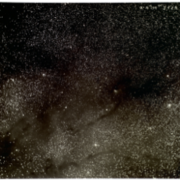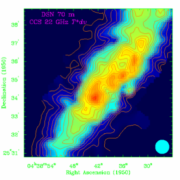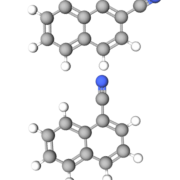News

Herbst Group: Using Radio Astronomy to Find Organic Molecules in Stellar and Planetary Nurseries
by Hannah Musgrove, UVA ChemSciComm
For decades, astrochemists have been using infrared (IR) spectroscopy to determine what types of molecules are present during the creation of stars.The data from this method have long identified the presence of polycyclic aromatic hydrocarbons (PAHs) in the clouds of gas and dust that eventually warm up to form stellar nurseries as well as new planets (Fig. 1).
 Figure 1. The dark clouds are full of molecules, but they cannot be seen in the visible, since dust particles block visible light. Radio waves can penetrate these clouds and molecular spectra identified.
Figure 1. The dark clouds are full of molecules, but they cannot be seen in the visible, since dust particles block visible light. Radio waves can penetrate these clouds and molecular spectra identified.
PAHs are a classification of molecules that contains two or more aromatic rings, occasionally decorated with additional functional groups (Fig 2.).
 Figure 2. An artist’s rendition of C60, the most famous PAH. Shown against a background of interstellar space.
Figure 2. An artist’s rendition of C60, the most famous PAH. Shown against a background of interstellar space.
The initial discovery of PAH molecules in space was profoundly impactful for the field, as these molecules are now thought to be among the initial ingredients that possibly lead to the formation of DNA and therefore relevant to the origins of life. However, since there are many types of PAHs, determining which specific PAHs are present in star- and planet-forming clouds can greatly impact our understanding of how these molecules form in an extraterrestrial environment. Though IR spectroscopy can reveal the presence of PAHs, it does not reveal the structures of these species and so cannot differentiate between different types of PAH molecules. For this reason, Eric Herbst and members of his group from the University of Virginia participated in an international collaboration with Brett Mcguire et al., which set out to determine the type and prevalence of PAHs in the cold dark interstellar cloud known as the Taurus Molecular Cloud (TMC-1) (Fig. 3) by utilizing radio astronomy with stacking and matched filtering analysis. TMC-1, an interstellar cloud relatively near to the earth, is well-known as a source of organic molecules.
 Figure 3. This dark cloud image is caused by dust particles that block out background stellar light. The long filamentary structure towards the bottom of the picture, is TMC-1.
Figure 3. This dark cloud image is caused by dust particles that block out background stellar light. The long filamentary structure towards the bottom of the picture, is TMC-1.
Radio astronomical methods utilize rotational spectroscopy, a spectroscopic method that can identify molecules based on how they rotate in space (Fig.4). This method can also determine the structure of molecules that contain molecular dipole moments.

The specific detection techniques used in this paper, stacking and matched filtering, allowed collaborators to identify two isomeric polar cyanonaphthalene (CNN) molecules within TMC-1 (Fig. 5). Graduate student Ci Xue who worked on the project explains, “CNNs are actually one of the most complex individual species on the list [of known astronomical molecules].
 Figure 5. Ball and stick 3D rendering of 1-CNN (top) and 2-CNN (bottom)
Figure 5. Ball and stick 3D rendering of 1-CNN (top) and 2-CNN (bottom)
Therefore, because of their complexity and relatively low abundances, the emission lines of CNNs have very weak signals. And, even with more than 600 hours of observational time, they are just barely over the noise levels.” Stacking and matched filtering increase the signal-to-noise ratio, though, by converting frequency signals into velocities to increase signals and comparing observed data to modeled data to help filter out noise. The two very similar CNNs discovered with these methods allowed the authors to determine the prevalence of these molecules in TMC-1, which subsequently led to some novel findings that are contrary to current theories of the chemical pathways leading to the formation of PAHs. There are two current theories on the mechanism of PAH formation that have been used to motivate continuing research on the formation of biologically relevant molecules: (1) a top-down approach where large stellar carbon debris is broken up into the basic components of these molecules, or (2) a bottom-up formation where smaller molecular components come together to create more complex PAH structures. The radioastronomical data collected in the paper demonstrate that the concentrations of the two cyanonaphthalenes are not in accord with what would be expected from either of these two current primary theories. This suggests that either a new reaction path theory is required to explain PAH formation, or the previously expected efficiencies of current reaction paths need to be reevaluated. This work opens new doors for astronomers, chemists, physicists, and mathematicians to further explore methods and theories that explain the origins of these essential molecules.
